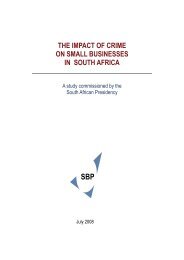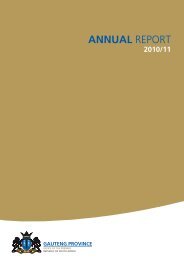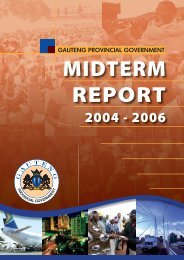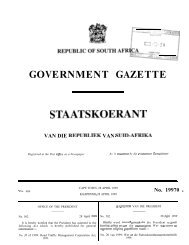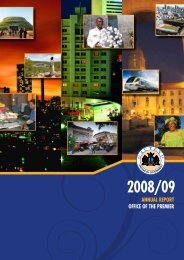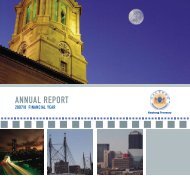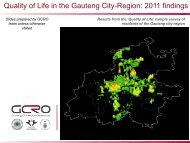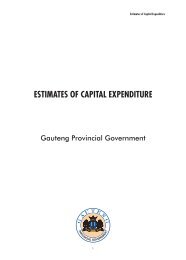the gauteng spatial development framework - Gauteng Online
the gauteng spatial development framework - Gauteng Online
the gauteng spatial development framework - Gauteng Online
Create successful ePaper yourself
Turn your PDF publications into a flip-book with our unique Google optimized e-Paper software.
Holistic perspectiveA philosophy based on <strong>the</strong> idea that <strong>the</strong> whole is greater than <strong>the</strong> sum of its parts, thatis, that a system may have properties over and above those of <strong>the</strong> parts and <strong>the</strong> way inwhich <strong>the</strong>y are organized. The view of multiple variables to see human problems in <strong>the</strong>irhistorical, economic and cultural contexts; <strong>the</strong> interconnection of <strong>the</strong> parts of a socio-culturalsystem; and <strong>the</strong> short-term and long-term ramifications of <strong>the</strong>se problems.Homo urbanusHomo urbanus is identified by dense living patterns, a tolerant acceptance of strangers,predictable behaviour based on largely agreed rules/ protocols; access to great amounts ofinformation; and a significant degree of total disconnection from <strong>the</strong> natural world.IIncentive ZoningZoning ordinance provisions in which developers receive bonuses, typically permission tobuild at a higher density or higher floor area ratio, in exchange for offering certain typesof amenities or economic <strong>development</strong> that are consideredimportant for <strong>the</strong> wider city context.IncrementalismA pragmatic <strong>the</strong>ory of growth and change derived from <strong>the</strong> field of public administrationand developed in response to <strong>the</strong> frequent inability of long-term comprehensive planningto meet its objectives, that accepts <strong>the</strong> slow process of change as being most practical anddesirable. Incrementalists believe that long-term comprehensive planning is a limited paradigmand that planners should ra<strong>the</strong>r proceed cautiously, planning and implementing on a stepby-stepbasis and responding to issues only as <strong>the</strong>y emerge.Implementation ProtocolsThe Intergovernmental Relations Framework Act, 2005 provides for <strong>the</strong> crafting of'Implementation Protocols', which organs of state in different, or <strong>the</strong> same sphere ofgovernment may enter into when a particular task, project or programme requires actionfrom more than one organ of state. The Guidelines provide guidance as to <strong>the</strong> legal andpractical matters around <strong>the</strong> setting up of such protocols. Of specific interest is <strong>the</strong> notionof 'joint programmes' within a particular sphere of government. In terms of <strong>the</strong> Guidelines,'joint programmes' are defined as 'Those programmes that transcend <strong>the</strong> conventionalorganisational boundaries in planning, budgeting and implementation resulting in a numberof departments/agencies/ ministries responsible for one aspect of <strong>the</strong> programme, althoughnone is responsible for it in its entirety'.Industrial Development Zones (IDZs)This intervention was instituted to enable places to respond to prospects for <strong>the</strong> export ofmanufactured products. All IDZs that have been identified were thus identified in closeproximity to harbours or international airports. IDZs were established to: (1) promote <strong>the</strong>competitiveness of South African enterprises through <strong>the</strong> export of value-added manufacturedgoods; (2) attract FDI; (3) learn from international operators regarding global manufacturingand production networks; and (4) develop links between enterprises in <strong>the</strong> zones and in<strong>the</strong> rest of <strong>the</strong> country outside <strong>the</strong> zones.InfillNew <strong>development</strong> on vacant parcels that are served by utilities and surrounded by urban<strong>development</strong> which have been bypassed in <strong>the</strong> normal course of urbanization. Infill sitesare normally scattered throughout <strong>the</strong> city and are usually only a few lots wide or in isolatedparcels within already built-up areas. The sites are vacant ei<strong>the</strong>r because <strong>the</strong> structuresformerly on <strong>the</strong>m were demolished or because <strong>the</strong>y remained undeveloped when <strong>the</strong>adjoining buildings were erected. Infill also includes re<strong>development</strong> and revitalization projectswhere existing structures in already developed areas are removed to allow for new construction.Infill Development (Also referred to as Urban Infill)The re<strong>development</strong> of under-utilised sites in existing urban areas. For example, <strong>the</strong>re<strong>development</strong> of a brownfield site such as a disused inner-city industrial site or for residentialapartments or <strong>the</strong> removal of a detached house in <strong>the</strong> suburbs to make way for townhouses.InfrastructureThe basic equipment, utilities, productive enterprises, installations and services essential for<strong>the</strong> <strong>development</strong>, operation and growth of a city. Infrastructure includes items like roads,utility lines, drainage structures, etc. A distinction is often made between engineeringinfrastructure such as roads, electricity, sewerage, water and social infrastructure such ashealth and education facilities.ANNEXURE E: GLOSSARY OF TERMSGAUTENG SPATIAL DEVELOPMENT FRAMEWORK 2011GAUTENG GROWTH AND DEVELOPMENT AGENCY202



